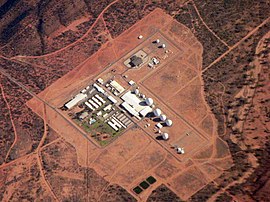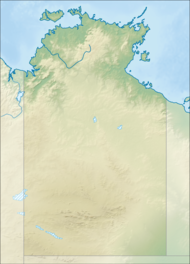Pine Gap
|
Pine Gap Northern Territory |
|
|---|---|
 |
|
| Coordinates | 23°47′56″S 133°44′13″E / 23.799°S 133.737°ECoordinates: 23°47′56″S 133°44′13″E / 23.799°S 133.737°E |
Pine Gap is the commonly used name for a satellite ground station approximately 18 kilometres (11 mi) south-west of the town of Alice Springs, Northern Territory in the centre of Australia which is operated by both Australia and the United States. Since 1988, it has been officially called the Joint Defence Facility Pine Gap; previously, it was known as Joint Defence Space Research Facility.
Partly run by the U.S. Central Intelligence Agency (CIA), U.S. National Security Agency (NSA) and U.S. National Reconnaissance Office (NRO), the station is a key contributor to the global surveillance network ECHELON.
The facility consists of a large computer complex with 14 radomes protecting antennas and has over 800 employees. A long-term NSA employee at Pine Gap, David Rosenberg, indicated that the chief of the facility at the time of his service was a CIA officer.
The location is strategically significant because it controls United States spy satellites as they pass over the one third of the globe which includes China, the Asian parts of Russia and the Middle East. Central Australia was chosen because it was too remote for spy ships passing in international waters to intercept the signal.
The facility has become a key part of the local economy.
Operations started in 1970 when about 400 American families moved to Central Australia. In 1999, with the Australian Government refusing to give details to an Australian Senate committee on treaties, intelligence expert Professor Des Ball from the Australian National University was called to give an outline of Pine Gap. According to Professor Ball, since 9 December 1966 when the Australian and United States governments signed the Pine Gap treaty, Pine Gap had grown from the original two antennas to about eighteen in 1999. The number of staff had increased from around 400 in the early 1980s to 600 in the early 1990s and then to an expected 1,000. The biggest expansion occurred after the end of the Cold War.
...
Wikipedia

